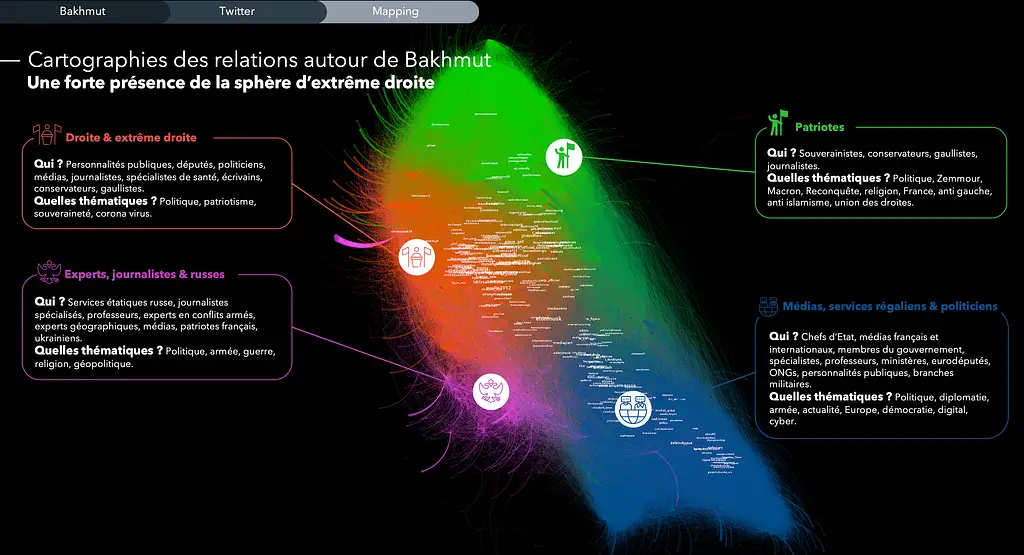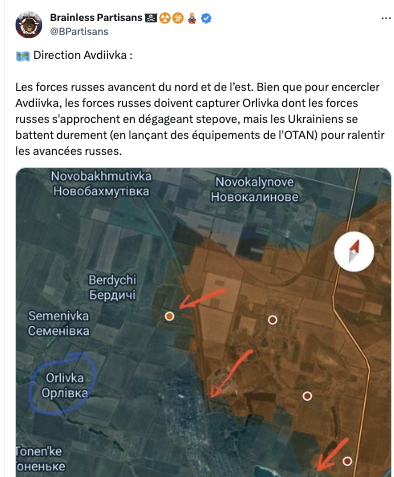Sommaire
Ukraine: How is Propaganda Spreading on Social Media?
As the Israeli conflict dominates the media space, Saper Vedere conducted a year-long detailed analysis of social media discussions about the Ukrainian conflict. From the situation in Bakhmut, where propaganda was in full swing, to the coverage of Adviika, where there is almost no content circulating, we decided to analyze:

- Who is active in the comments surrounding this conflict?
- What are they saying?
- Is there a difference between the networks?
Note that a more detailed analysis is available here.
Main Findings
- Conversations now heavily rely on purely military analysis, with videos from both sides attempting to prove that each has the upper hand. Previously, discussions included both military and political propaganda. Now, with media attention waning, only military interpretations are visible.
- Propaganda has clearly shifted into fixed patterns, with content spreading on Telegram and being reported by satellite accounts on X (formerly Twitter).
- The death of Yevgeny Prigozhin has significantly impacted Russian propaganda on social media: Wagner's African networks have clearly come to a halt. Similarly, activity within the far-right and sovereigntist circles has drastically declined. Notably, many accounts that were previously key players have suddenly stopped operating.
- There is a noticeable Western disinterest in combat zones. Bakhmut generated far more reactions and media coverage compared to Adviika. The prolonged conflict and numerous national and international news stories largely explain this.
- Twitter Blue and Mass Following: Pro-Russian accounts are clearly using Twitter Blue. However, despite numerous interactions (retweets and others), the visibility as measured by actual views and impressions is extremely low in terms of ratio, indicating that these are militant or propaganda efforts.
Who is Active in the Comments Surrounding the Conflict?
Cartographic analyses on X reveal clear divides between the groups involved. Interestingly, the difference between the communities discussing Bakhmut and Adviika is quite telling: there is a total decline between the two areas of action.


Conversations are now less pressured on experts:


There are also expert defense communities on LinkedIn, with pro-Russian arguments in noticeable decline:


On Facebook, African propaganda pages flooded discussions about Bakhmut. Since Yevgeny Prigozhin’s death, these have completely disappeared from conversations about Adviika.


What Techniques are Used by Pro-Russians?
Techniques are relatively constant in communities.
- Mass Following: They primarily engage in mass following to be followed back by many people. (Note: the account Circonscripti18 has not been active since August 10, 2023).


- Subscription to Twitter Blue: Accounts use Twitter Blue subscriptions to increase their visibility.
- Resilience: They consistently link to Telegram channels, whether in their posts or biographies, knowing their accounts are precarious.

- Broader Narratives Beyond the War: These accounts discuss not only the war but also a range of issues relevant to Russian geopolitics: vaccines, Europe, anti-Israel, and pro-Hamas narratives.
- Frequent Retweets and Sustained Activity Over Time: It’s particularly odd when highly active accounts suddenly stop, with many ceasing activity in August or late September.
- Use of Maps: There is a real "war of maps" on social media, with efforts to display occupation zones and territorial gains.

- Use of "Experts" from the Opposing Side: They frequently highlight European experts or former NATO soldiers who support Russian narratives.

Behind these accounts, there are others with less overt editorial lines, more "expert" in nature, like the account @RussiesInfos, which curates European press articles unfavorable to Europeans and Ukrainians.
Finally, on Facebook, similar very basic and "primary" message operations can be identified.

What are the messaging axes?
On the pro-Russian side, multiple types of propaganda are developed through well-established networks over the years. However, since the death of Wagner’s leader, Yevgeny Prigozhin, there has been a noticeable decline in activity on Facebook and Twitter.

When these propaganda axes are broken down into opinions, it’s observed that the main themes are relatively basic.





